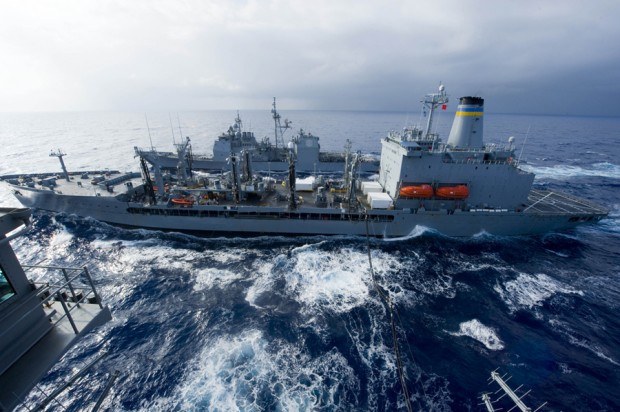LIHU‘E — Many of Kauai‘i’s environmentalists aren’t sharing in the excitement of the world’s largest international maritime exercise, Rim of the Pacific Exercise 2012. The biennial exercise known as RIMPAC is hosted by the U.S. Pacific Fleet, with some ships
LIHU‘E — Many of Kauai‘i’s environmentalists aren’t sharing in the excitement of the world’s largest international maritime exercise, Rim of the Pacific Exercise 2012.
The biennial exercise known as RIMPAC is hosted by the U.S. Pacific Fleet, with some ships of the 22 participating nations training with hull-mounted active sonar around Hawai‘i’s islands. Despite efforts to reduce deadly exposure of high-pressure sound waves to sea mammals, advocates say the measures fall short.
“Naval warfare and the main issue of active sonar and explosions is going to kill animals, including some that are going extinct,” said Dr. Gordon LaBedz of the Surfrider Foundation’s Kaua‘i Chapter.
There have not yet been any ship or air sightings related to RIMPAC exercises near Kaua‘i, including Pacific Missile Range Facility, he said. The organization said 600 volunteers are keeping watch during the month-long training to report mammal activities. The exercise started July 2 and ends Aug. 3.
“The last time RIMPAC was here they were all over the Westside, with sonar blasting not even a mile offshore,” LaBedz said. “There were ships with the big speakers in the back, and it was just awful.”
LaBedz said that posting a sailor on deck to watch for whales falls short of curtailing invasive training that affects more than just sea mammals.
“There are only a few hundred false killer whales left, and these guys are saying what they are doing is important,” LaBedz said.
In 2006 the Surfrider Foundation joined a Natural Resources Defense Council lawsuit against the Navy over sonar use during RIMPAC. The out-of-court settlement resulted in the Navy agreeing not to use sonar near the Northern Hawaiian Islands.
RIMPAC is designed to enhance the tactical capabilities of participating units in major aspects of maritime operations at sea, said Mark Matsunaga, a public relations specialist with the U.S. Pacific Fleet.
Active sonar training ensures the safety and security of sea lanes around the globe, he added.
“We’ve been doing this stuff for decades and there has been no substantial harm to the marine environment,” Matsunaga said.
The Navy is a leading funder of marine mammal research. Matsunaga said there is a lot to be learned about marine mammals, and that the Navy has a policy of adaptive management.
“The Navy’s policy is to operate in full compliance with environmental laws,” he said. “To this end, they analyze the potential effects of training on the environment and cooperate with environmental regulatory agencies, as appropriate, based on those effects.”
Marine mammals, sea turtles, fish and other marine life in the ocean are affected by the intensity of sound, which is relative to pressure and its amplitude. Measured in decibels, sound travels faster in the density of water but Matsunaga said it should not be compared with decibel measurement in the air, but rather on the distance from the transmission point.
LaBedz said there were several ships around Kaua‘i during the 2004 RIMPAC, and he doesn’t believe that it was a coincidence that 150 to 200 melon-head whales came into Hanalei Bay during that time.
Matsunaga said the Navy had no craft near the melon-head whales, and that a calf that died had been separated from its mother and showed evidence of malnutrition. He said a similar incident occurred at Hilo Bay in 1841 before the use of sonar.
The damage to mammals is more obvious near shore because sea mammals will beach themselves or die near shore, LaBedz said. There is no way of knowing the number of affected mammals in the open ocean because they sink and die after losing their hearing from a sonar blast.
“A deaf whale is a dead whale,” LaBedz said. “They will just drown and we will never know. But when they come close to shore we will see.”
The Navy reported possible sonar exposure to approximately 100 mammals in its 2006 RIMPAC report. It details how 25 air and ship sightings of more than 70 mammals resulted in shutting down active sonar for a total of eight hours.
At the same time, NOAA estimated that 256 marine mammals were affected by 472 hours of sonar use. They estimated 33,000 marine mammal disturbances.
Matsunaga said the numbers blur the amount of dangerous exposure to slight disturbances.
The Navy now scans an area before training and maintains surveillance throughout an exercise. Ships use passive sonar to listen for whales before turning on a transmitter.
The Navy has about 300 ships, and about 50 percent of them use sonar of any kind, Matsunaga said. There are even fewer ships that employ active sonar.
“When sending a ping, you are basically making everyone within earshot aware of who you are,” Matsunaga said.
The new mission for active sonar is to detect the increasing number of silent-running diesel-electric submarines. Sonar remains a 40-year-old technology that does not have long-distance capability.
Pacific Command is currently operating under a 2009 Environmental Impact Study in place for Hawai‘i and the surrounding ocean. It now has a dozen or more EIS in place for training areas and ranges and at U.S. bases.
“We are currently working on the next round of EIS,” Matsunaga said.
The new EIS will look closer at torpedo and gunnery exercises at Kaula Islet. The mitigation is based on more than 300 sound-producing activities and swapping out optimum components.
The public is encouraged to report unusual behavior by marine mammals during RIMPAC to the NOAA stranding hotline at 1-888-256-9840, and to call LaBedz at 337-9977, or email surfriderkauai@gmail.com.
• Tom LaVenture, staff writer, can be reached at 245-3681 (ext. 224) or by emailing tlaventure@thegardenisland.com.


